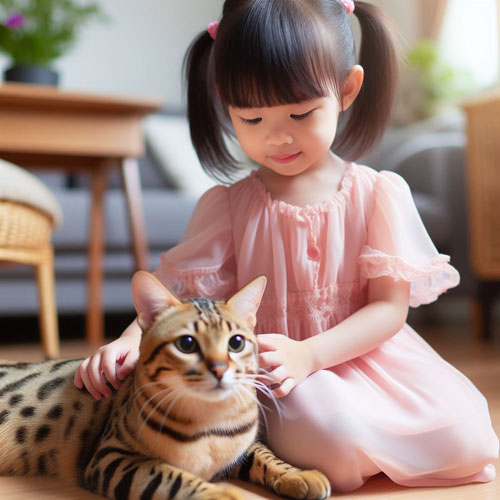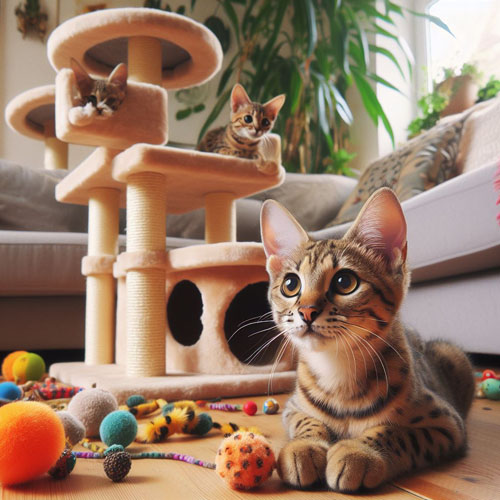A Beginner’s Guide to Owning and Taking Care of Savannah Cats
Introduction
For many pet enthusiasts, Savannah cats—known for their striking appearance and lively personalities—are the epitome of perfection. It’s critical to understand what makes these magnificent animals unique and how to give them the best care if you consider bringing one into your house. You can find all the information you require to own and care for a Savannah cat in this guide.
Selecting the Ideal Savannah Cat for Your Household
It is essential to understand the generational differences when choosing a Savannah cat. The F1, F2, and F3 generations designate the filial degree with its wild ancestor, the Serval. While F2 and F3 cats have a slightly lower proportion of Serval genetics, F1 cats are the closest, being half Serval. This difference influences how they look, how they behave, and what they need.
In making this choice, evaluating your family’s lifestyle is essential. A later-generation cat, such as an F3, may be more appropriate if your home is constantly busy because they are more tolerant of a busy household. On the other hand, an F1 or F2 Savannah might be an exciting addition if your home is calmer and you have prior feline experience.
One cannot stress the importance of breeders in the kitten selection process. A trustworthy breeder will assist you in finding a cat that fits your lifestyle and give you essential information regarding cat care. To guarantee that the pet you bring home is healthy, they should also provide health records and genetic testing results.
Families with children should pay special attention to temperamental factors. Although Savannah cats are generally gregarious and friendly, younger children may find the earlier generations of the breed to be too independent or boisterous. Younger family members tend to get along better with later generations because they are typically more relaxed.
Finally, many factors, including your health and genetics, influence your choice. Although most Savannah cats are healthy, they can be susceptible to specific genetic conditions, like any other breed. A reputable breeder will test for these and explain any possible health issues.
Getting Ready for a Savannah Cat in Your House
The first step in bringing your Savannah cat into your house is to ensure they are safe. Because of their high energy level and athleticism, these cats need a safe place to play and explore. Take out anything dangerous and tuck away tiny objects or loose wires they might gnaw on.
A litter box, various toys, water bowls, and premium cat food are necessities for Savannah cats. Since they are lively and intelligent cats, interactive toys that pique their interest in hunting are perfect. Since cats enjoy climbing and surveying their environment from above, consider purchasing a sturdy scratching post and a cat tree.
Creating designated spaces for play in your house can assist in taming their curiosity and energy. These places should have lots of room for running and jumping and should be away from breakable objects. Remember that Savannah cats can jump up to eight feet vertically, so your play area should consider that.
Cat safety also requires childproofing, particularly if you have small children. Make sure small toys, objects that could choke someone, and hazardous materials are out of reach. Also, instruct your kids on treating the cat with respect and safety.
It is advisable to acclimate the cat to its new residence gradually. Let them explore one room at a time to begin. They can adjust without feeling overburdened, thanks to this. Allow them to come to you on their terms and exercise patience.
Bonding Your Child and Savannah Cat
Your child and Savannah’s cat should interact gently to form a strong bond. Teach your child to pet the cat and gently recognize its discomfort or disinterest. The child and the cat must feel safe and comfortable during these interactions.
At the beginning of their relationship, supervision, and safety are essential. It would be wise to never leave a small child alone with a cat until they can interact safely. The friendliest cat can become overwhelmed or scared and scratch or bite unintentionally. Teaching kids about cat care builds bonds and responsibility. Children can learn about caring for others by feeding, grooming, and playing.
Harmony requires mutual respect and understanding. Please help your child read the cat’s body language and respect its limits. Let the cat have its space if it leaves during playtime. Recognizing your cat’s comfort zone will help reduce stress. All cats need a safe place to relax, including Savannah cats. Ensure they have a peaceful place to escape for alone time.
Training and Socializing Your Savannah Cat with Kids
Basic Savannah cat training is similar to other breeds, but Savannahs are clever and may respond well to more advanced training. Reward good behavior with treats and praise. Socialize children and pets slowly and under supervision. Savannah cats are friendly, but like all animals, they have personalities and comfort levels. Introduce them gradually to new people and pets, watching for stress or discomfort.
Early behavioral intervention is crucial. Consult a vet or cat behaviorist if your cat scratches furniture or acts aggressively. They can advise and explain the behavior. Savannah cat training works best with positive reinforcement. Rewards good behavior instead of punishment, which can cause fear and mistrust. This improves your relationship and makes cat training fun. A harmonious home needs boundaries and rules. Training requires consistency so the whole family knows the cat rules. It helps the cat understand expectations and avoid confusion.
Conclusion
Having a Savannah cat is a fulfilling experience. Intelligent, attractive animals make interesting and loving friends. When given the right training, care, and surroundings, savannah cats flourish and make cherished family members. A Savannah cat needs patience, understanding, and regular care to live a happy and healthy life.





